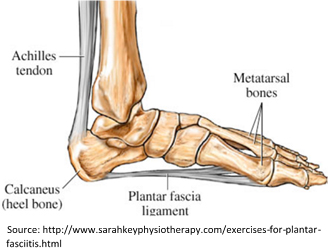The plantar fascia is a structure under your foot that functions like a muscle or ligament. It reaches from your heel bone, across your arch region and to the ball of  your foot. Plantar fasciitis occurs when this structure gets injured or inflamed.
your foot. Plantar fasciitis occurs when this structure gets injured or inflamed.
As the plantar fascia crosses the arch, it is constantly lengthening and shortening when you walk or run. This makes it very susceptible to overuse injuries, especially if you suddenly start doing more walking than usual such as when you start trying to increase your fitness or go on a holiday. It also means that if your foot rolls in (pronates) more than what is considered normal, your arch is constantly a little bit longer and so the plantar fascia may be constantly overstretched and so even more susceptible to injury.
Plantar Fasciitis is typically felt as heel pain which is a significantly worse first thing in the morning or after resting.
While Plantar Fasciitis is a very common condition, it can be quite resistant to treatment and so it is important to follow the direction of your podiatrist to the best of your ability.
Treatment:
- Your podiatrist will do their best to help you treat the cause of your plantar fasciitis as well as manage the symptoms. The cause differs from person to person. Examples of treatments may include:
- Strapping for temporary management (same purpose as orthotics but not usually as effective).
- Orthotics to limit how much your foot rolls in or to improve foot function and so how much the plantar fascia is stretched or used.
- Heel lifts to reduce the pull on the plantar fascia as it is connected to your Achilles tendon
- Therapeutic ultrasound to help manage the pain by providing mild heat and a micro-massage (using sound waves) to the area.
- Advice about your shoes as some shoes accommodate orthotics better than others and some shoes are also more likely to aid in recovery and prevent recurrence than others.
- Prescribe stretches or strengthening exercises as appropriate for you.
- What you should do at home to help:
- You don’t have to stop activity completely, just do less, maybe half as far or half as often.
- Roll your arch and heel area on a frozen water bottle (be careful not to slip afterwards though!)
- Stretch your calf muscles and plantar fascia and do all exercises as recommended by your podiatrist
- Spend as much time in possible in any shoes and/or orthotics recommended by your podiatrist


Comments are closed.